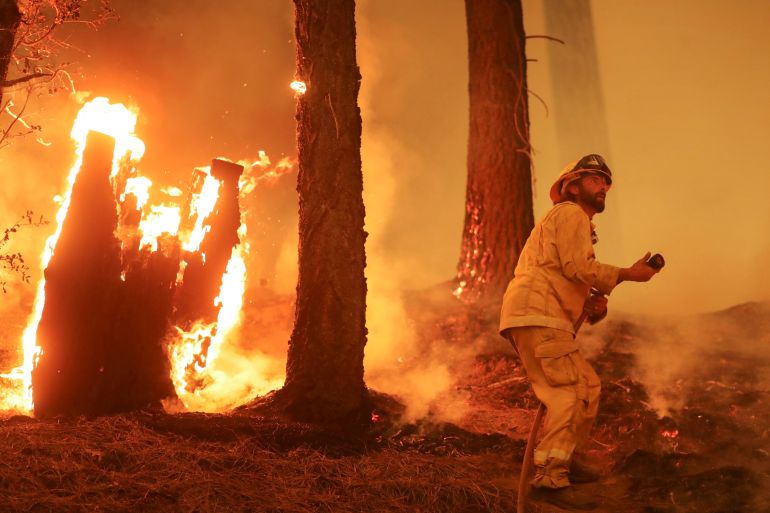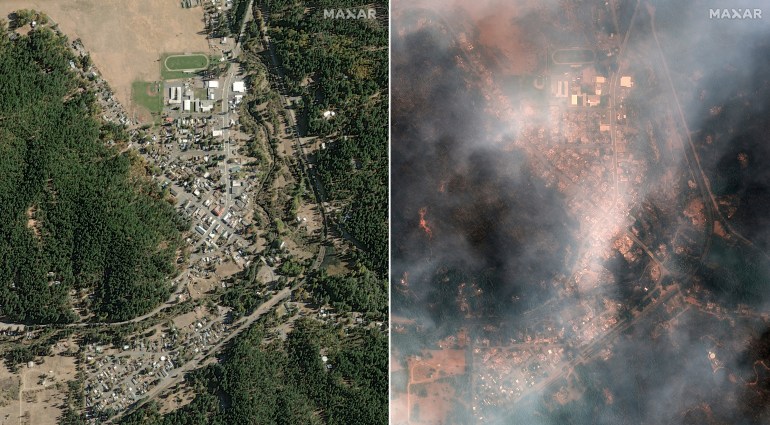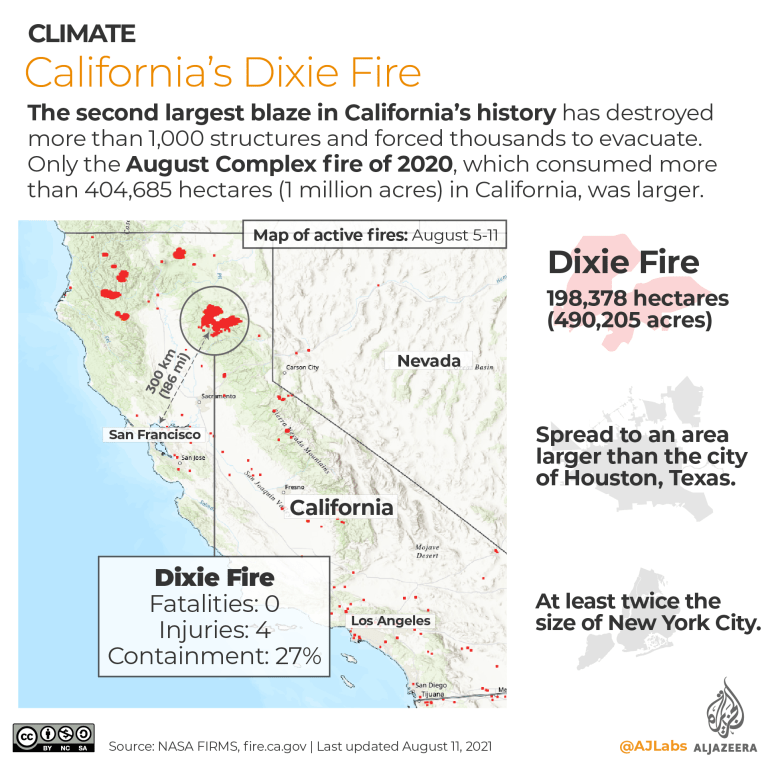California’s Dixie Fire grows as heat wave hits western US
Extreme heat and drought continue as more than 100 fires burn throughout the US, mostly in the west.

California’s second-largest wildfire in recorded history continues to grow after destroying nearly 550 homes while authorities in Montana order evacuations as a wind-driven blaze roars towards several remote communities.
The dangerous fires were among some 100 large blazes burning Wednesday across 15 states, mostly in the West, where historic drought conditions have left lands parched and ripe for ignition.
Keep reading
list of 4 itemsMegadrought ‘taxing’ US water reservoirs and fuelling wildfires
How should the US prepare for another intense wildfire season?
California wildfire rages: ‘We didn’t expect a monster like this’
The east end of Northern California’s enormous Dixie Fire flared up Tuesday as afternoon winds increased, fire officials said.
Burning through bone-dry trees, brush and grass, the fire has destroyed at least 1,027 buildings, more than half of them homes in the northern Sierra Nevada. Newly released satellite imagery showed the scale of the destruction in the small community of Greenville that was incinerated last week during an explosive run of flames.

The Dixie Fire, named after the road where it started on July 14, by Tuesday night covered an area of 1,984sq km (766sq miles) and was 27 percent contained, according to the California Department of Forestry and Fire Protection. At least 14,000 remote homes were still threatened.
The Dixie Fire is the largest currently burning in the US. It is about half the size of the August Complex, a series of lightning-caused 2020 fires across seven counties that were fought together and that state officials consider California’s largest wildfire overall.

In southeastern Montana, communities in and around the Northern Cheyenne Indian Reservation were ordered to evacuate as the Richard Spring Fire grew amid erratic winds.
The order was expanded Tuesday night to include Lame Deer, a town of about 2,000 where people who fled the fire earlier in the day were sheltering. About 600 people in the small community of Ashland and nearby communities were also ordered to leave.
The flames came within about 0.4km (0.25 miles) of a subdivision outside Ashland along the Tongue River. Powerful gusts Tuesday caused the blaze to explode across more than 518sq km (200sq miles) as the fire jumped roads, creeks and fire lines that had been created in an attempt to prevent it from growing.
Extreme heat
Meanwhile, temperatures rose across the US Pacific Northwest on Tuesday as residents of Portland, Oregon and Washington state prepared for a third punishing heat wave of the summer.
The National Weather Service issued excessive heat warnings for Portland and Medford, Oregon, much of the Columbia River Gorge and Willamette Valley, along with the Vancouver, Washington area.
“Extreme heat will significantly increase the potential for heat-related illnesses, particularly for those working or participating in outdoor activities,” the weather service said in an advisory.
Oregon Governor Kate Brown declared a state of emergency in anticipation of the sweltering heat and the city opened cooling centers for residents without air conditioning.
Power grids could be tested, especially during the hottest days, forecast to come on Thursday and Friday as a high pressure dome builds over the Pacific Northwest.
Heatwaves and historic drought tied to climate change have made wildfires harder to fight in the American West. Scientists have said climate change has made the region much warmer and drier in the past 30 years and will continue to make the weather more extreme and wildfires more frequent and destructive. The fires across the West come as parts of Europe are also enduring large blazes spurred by tinder-dry conditions.